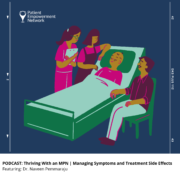What Factors Guide Treatment Choices for ET, PV & MF?
What Factors Guide Treatment Choices for ET, PV & MF? from Patient Empowerment Network on Vimeo.
When making a myeloproliferative neoplasm (MPN) treatment decision, several factors come into play. Dr. Brady Stein explains what criteria he considers to determine the optimal approach for a patient’s unique situation and specific MPN.
Dr. Brady Stein is a hematologist focusing on myeloproliferative neoplasms (MPNs) at the Robert H. Lurie Comprehensive Cancer Center of Northwestern University. Learn more about Dr. Stein, here.
Related Resources

|

An Expert Shares Key Steps to Take Following an MPN Diagnosis |

|
Transcript:
Katherine:
Dr. Stein, I understand that therapy is different for each of the MPNs. What do you take into consideration to help guide the treatment choice?
Dr. Stein:
So, that’s a good question. It’s going to require maybe a little bit of a longer answer. It’s fairly nuanced. The treatment of ET and PV – right now, the goals are – the treatment is largely based on a patient’s vascular risk. That’s largely what influences the choice of therapy. And so if a patient has a perceived high risk for vascular complication in ET or PV, that’s when we’re going to be a little bit more aggressive – so, more aggressive than watchful waiting, more aggressive than using aspirin alone, more aggressive than using phlebotomy and aspirin alone in polycythemia vera.
So, if the patient has a higher vascular risk, in general, we’re going to need to do something more than what we consider to be the standard, and that’s where we enter into the question of cytoreductive therapy – therapies designed to lower blood counts apart from phlebotomy.
Maybe that’s going to change. I hope it will change. Right now, the therapy for ET and PV is generally reactive. We either predict high risk and react, or if a patient is lower risk, if something changes – God forbid there’s a blood clotting event – then we may react to it.
So, ET and PV treatment are generally more reactive. In myelofibrosis, certainly, there are patients who can have lower risk and minimal systems, and there are some patients who can be observed with watchful waiting for sure, but more patients are symptomatic, more patients are going to need therapy in myelofibrosis, and there’s sort of two big categories of therapy.
One is the risk-adapted, deciding if the patient is eligible and should consider stem cell transplant versus thinking only about medical therapy in a patient that may be transplant-ineligible.
And, the medical therapy is based on the worst symptoms for the patient. Is the symptom that’s the worst the spleen enlargement? Is it excessive fatigue? Is it weight loss, or inflammation, or fevers? If it’s that category of symptoms, we have a set of therapies. If it’s really the anemia that is the most problematic issue, then we follow a paradigm to treat anemia.
Katherine:
What about considerations like the patient’s health, age, genetic markers, things like that?
Dr. Stein:
So, of course. The comorbid illnesses can influence therapy choices, so if a patient is older and has other medical conditions, they’re not going to be treated as aggressively.
So, in myelofibrosis, if a patient is older, with other medical illnesses, then it may be inappropriate to consider something like stem cell transplant, for sure. So, age and health comorbidities are highly influential. In terms of genetic features, if you’re asking about things like the type of mutation that a patient has, right now, we’re – in terms of vascular risk, for ET, the type of mutation matters for blood clotting risk, so if patients have different mutations, it could be treated differently. In other subtypes, like PV or myelofibrosis, in general, there’s – the mutation can be prognostic, but it may not be – it may not lead to a precise and distinct therapy just yet.









